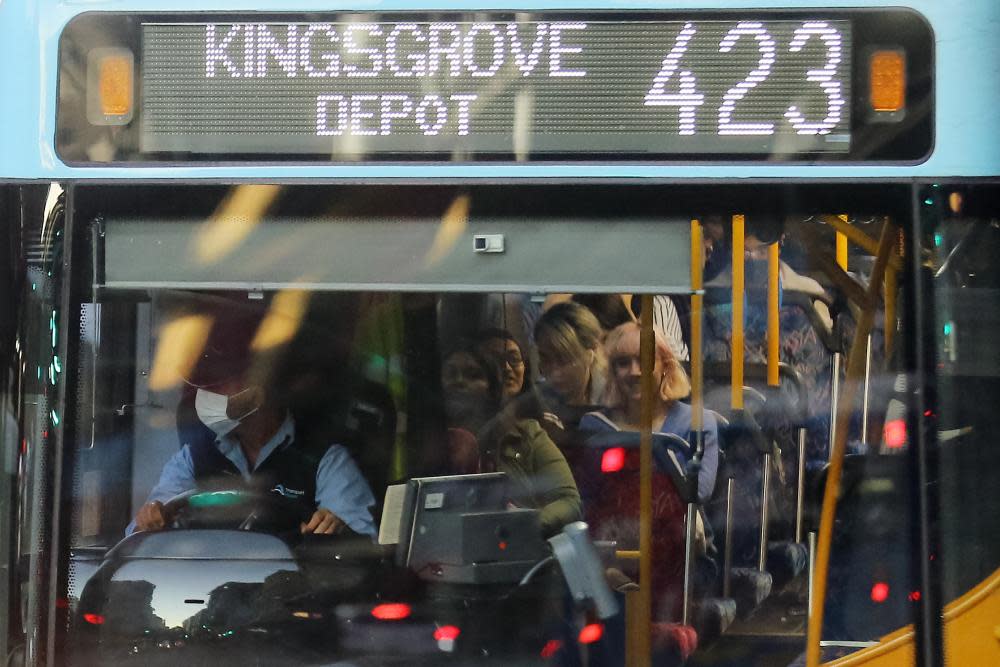Parting the ‘Red Sea’: Sydney buses would sail through intersections under automated lights plan

Sydney’s traffic light patterns would be interrupted to allow buses to glide through busy intersections, under a plan to get more commuters to take the bus.
The plan, outlined by the New South Wales government’s bus industry taskforce in its white paper for better bus services, is designed to address frustration such as long waits, delays and getting stuck in traffic that have become front of mind for passengers.
Sydney’s traffic jams are deterring workers from riding buses and costing the NSW economy tens of millions of dollars each year in lost time, the white paper found.
Related: Mutiny on the Sydney commute: ‘pirate bus’ hits the road after privatisation leads to axed routes
The paper estimated that across greater Sydney, traffic affecting buses was costing residents $53m in lost productivity, with the figure to grow to $140m by 2036 and $230m by 2056.
The white paper says so-called “bus priority” policies such as bus lanes and traffic light signalling tweaks would incentivise commuters to ditch their cars by making bus travel more frequent and reliable.
John Lee, chair of the taskforce and former chief executive of the NSW State Transit Authority, likened the plan to the biblical story of Moses parting the Red Sea.
“Except instead of the Red Sea, we want the red paint to mark bus lanes, that’s for sure, taking some of the road space away from cars for buses,” Lee said.
Existing priority lanes in Sydney’s network use a “B light” that allow buses to accelerate first, whereas the new technology would be similar to how trams on the light rail network influence traffic lights. “The bus actually tells the lights up ahead that it’s coming and it automatically changes the light so they don’t have to sit and wait.”
Lee said the bias towards train infrastructure in growth planning areas may have to be reconsidered in the face of ballooning construction costs, while rapid bus routes could be done far more cheaply and quickly.
The white paper identified 39 potential rapid bus routes with “turn up and go” frequencies across greater Sydney’s six cities – spanning Newcastle to the Illawarra and far western Sydney. Lee hoped about five routes will be selected and introduced in the next few years.
He said most traffic intersections already have the potential to incorporate bus priority – they just need to be switched on.
Central to the paper’s arguments is the success of the B-Line – Sydney’s only current rapid bus route, between the CBD and the northern beaches. Doubledecker buses with lane and traffic signal priority run every three to four minutes in peak times, every 10 minutes off peak, and half-hourly between midnight and 4am.
Since the B-Line’s introduction in 2018, end-to-end travel times were reduced by about 15%. Research suggests the B-Line was responsible for taking 5% of regular commuting cars off the roads between the northern beaches and the city, Lee said.
“The proof is in the pudding: the bums on the seats,” Lee said.
The taskforce has separately identified a state-wide bus driver shortage as a serious problem and demand for drivers is set to increase during upcoming construction on the Bankstown train line.
In anticipation of the worsening shortage, the state has introduced incentives for drivers, such as free public transport travel and $6,000 cash bonuses for new starters.
David Babineau, NSW division secretary at the Rail, Tram and Bus Union, backed the widespread use of special traffic signals because it would spare buses from being “at the mercy of traffic”.
“Think of it as the difference between riding your bicycle around Sydney compared with riding it around in cycleway areas – you know it’s safe,” he said.
Harri Bancroft, the mobility adviser at the Committee for Sydney, said rapid bus routes were “one of the best and cheapest ways to get our public transport network working better”.
Related: NSW government to consider reviving axed bus services, but won’t rip up private contracts
The taskforce was set up by the Minns government in response to claims of poor service outcomes resulting from privatised contracts, which saw several routes axed and allegations private operators were cancelling services entirely so as to not harm their on time performance KPIs.
Natalie Ward, the opposition transport spokesperson, criticised the white paper and Lee’s salary, saying the proposals provided “no solutions for commuters”.


